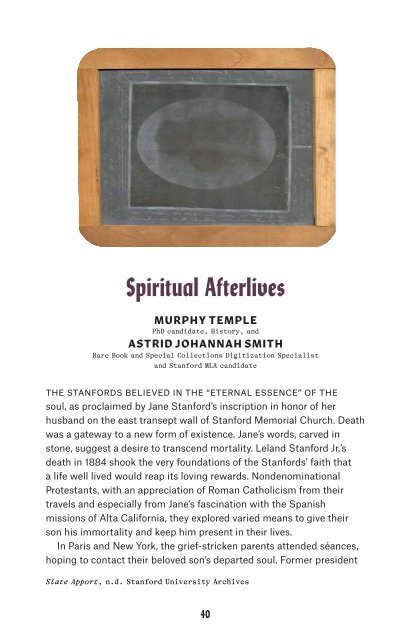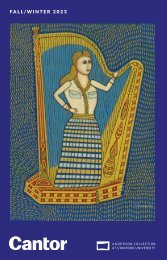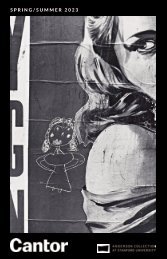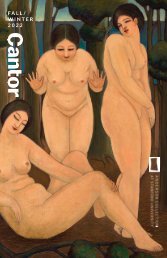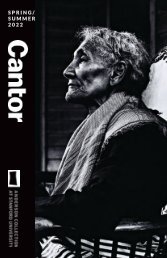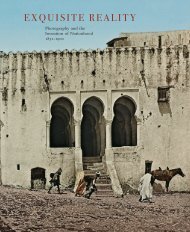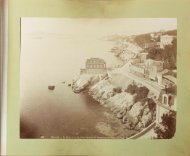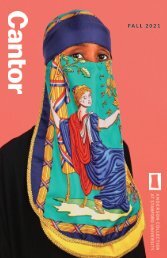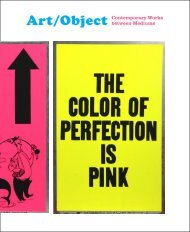Gallery Guide | The Melancholy Museum
Using over 700 items from the Stanford Family Collections, artist Mark Dion’s exhibition "The Melancholy Museum" explores how Leland Stanford Jr.’s death at age 15 led to the creation of a museum, university, and—by extension—the entire Silicon Valley.
Using over 700 items from the Stanford Family Collections, artist Mark Dion’s exhibition "The Melancholy Museum" explores how Leland Stanford Jr.’s death at age 15 led to the creation of a museum, university, and—by extension—the entire Silicon Valley.
You also want an ePaper? Increase the reach of your titles
YUMPU automatically turns print PDFs into web optimized ePapers that Google loves.
Spiritual Afterlives<br />
MURPHY TEMPLE<br />
PhD candidate, History, and<br />
ASTRID JOHANNAH SMITH<br />
Rare Book and Special Collections Digitization Specialist<br />
and Stanford MLA candidate<br />
THE STANFORDS BELIEVED IN THE “ETERNAL ESSENCE” OF THE<br />
soul, as proclaimed by Jane Stanford’s inscription in honor of her<br />
husband on the east transept wall of Stanford Memorial Church. Death<br />
was a gateway to a new form of existence. Jane’s words, carved in<br />
stone, suggest a desire to transcend mortality. Leland Stanford Jr.’s<br />
death in 1884 shook the very foundations of the Stanfords’ faith that<br />
a life well lived would reap its loving rewards. Nondenominational<br />
Protestants, with an appreciation of Roman Catholicism from their<br />
travels and especially from Jane’s fascination with the Spanish<br />
missions of Alta California, they explored varied means to give their<br />
son his immortality and keep him present in their lives.<br />
In Paris and New York, the grief-stricken parents attended séances,<br />
hoping to contact their beloved son’s departed soul. Former president<br />
Slate Apport, n.d. Stanford University Archives<br />
Ulysses S. Grant and his wife, Julia, introduced them to Doctor John<br />
Philip Newman, a Methodist minister known for his rousing brand<br />
of Spiritualism, and his wife, Angeline, who acted as a medium. <strong>The</strong><br />
Stanfords invited the Newmans to accompany them to California<br />
to preside over Leland Jr.’s memorial service on November 27, 1884.<br />
Leland Sr. remained skeptical that the Newmans’ séances would<br />
permit them to communicate with their son, and Jane reluctantly<br />
agreed that the results were disappointing. <strong>The</strong> Newmans returned<br />
east, leaving behind rumors that the Stanfords were committed<br />
Spiritualists who founded their university by consulting a medium.<br />
For Leland Sr., immortality took the concrete form of a university. He<br />
used his immense fortune to rethink education, building an institution<br />
to prepare students—men and women, rich and poor—“for personal<br />
success and direct usefulness in life.” He called them missionaries for a<br />
new ideal. Late in life, his tender affection for his equine progeny struck<br />
contemporaries as filling the emotional void created by his son’s death.<br />
Jane’s views of how her spirit might exist in perpetuity evolved<br />
with the university. She envisioned Memorial Church as Stanford’s<br />
heart and soul, nurturing the spiritual lives of her adoptive sons and<br />
daughters while memorializing her family. <strong>The</strong> sandstone, stained<br />
glass, and inscriptions in the church—her “jewel box”—were of her own<br />
design. While visiting her brother-in-law Thomas Welton Stanford<br />
during a 1903 trip to Australia, she found his intense spiritualism<br />
disturbing—a sign that she had moved beyond her early efforts to<br />
speak with the dead by any means. Welton bequeathed an endowment<br />
for psychic studies at Stanford with his collection of apports<br />
(objects enabling communication with the dead). While fated to be a<br />
perpetually grieving mother and widow, Jane remained frustrated by<br />
Spiritualism, finding her son more readily in the church and private<br />
home chapels, in the mausoleum, and in the survival of his collection.<br />
In his 1906 Founder’s Day address, philosopher and psychologist<br />
William James emphasized the university’s spiritual qualities. He<br />
argued that spiritual life arose from the contagious effect of human<br />
spirits imprinting themselves in the objects, places, and ideas that they<br />
touched or fostered. While the bodies of the Stanford family rest in<br />
their mausoleum—Jane situated eternally between her husband and<br />
her son—their spirits still suffuse every aspect of the university around<br />
them, including the museum, where they live on through artifacts that<br />
evoke their own curiosity, taste, and passion for discovering the world.<br />
40<br />
41


